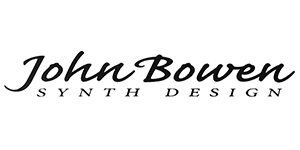
John Scott Bowen began his professional career in 1973 in Moog. In 1976 he met Dave Smith and helped him work on the Model 800 Sequencer and the Model 700 Programmer. Their collaboration led to the creation of the popular Prophet 5 (in which John was responsible for the development of 40 preset programs) and a number of other Sequential Circuits products - 99% of sounds and sequences were devised by Bowen. He was also responsible for waveform geneation in Prophet VS and designing the user interface for Prophet 5, Prophet 10, Prophet 600, Prophet T-8, Prophet VS, Drumtraks, 6-Trak, MultiTrak, Tom, Max, Studio 440 and Prophet 2000.
After Sequential moved to the Yamaha “camp” in 1987 John and the development team agreed to collaborate with Korg, which made Bowen the manager of Wavestation series (1989-1992). In 1996 he demonstrated OASYS keyboard at NAMM show and Musikmesse. Then he got down to the work on Korg Z1 voices, and when OASYS technology was brought back to life he returned to designing the user interface for OASYS PCI synthesizers and effects.
In the late 90s John Bowen joined the German company Creamware to create modules which used Pulsar/Scope computer systems. There he released a decent number of plug-ins on a digital signal processor platform. Even Bowen himself thought it was crazy to quit Korg for the new little-known project in Germany, the task within which was to understand the Scope development kit within 3 weeks, to replace Mac with the just-appeared Windows 95 and 98 (and the operating system was in German language!) and create a few (and already tested) modules for Pulsar/Scope systems during the given working period. It’s no surprise that such cooperation wasn’t a strong one. Bowen decided to found his own company - Zarg Music. Thanks to the experience he got working with the Scope platform Orion appeared - the first plug-in made by Bowen’s brand. Dark Star was already a little bit more complicated featuring 4 separate filter sections. The simple Comb Plus was followed by Ambient. While working on it John found another criterion distinguishing large manufacturers from independent designers: the first ones considered polyphony to be a priority, small entrepreneurs had complete freedom in functional refinement, and this understanding largely predetermined Bowen's further engineering intentions.
The concept of Red Dwarf became a real breakthrough in John's career. By trying and failing he got a system the configuration of which could be determined by a user. In order to simplify the control panel he followed a modular approach. Red Dwarf was based on Bowen’s designs rejected by Creamware as well as on his Comb Plus Pro, Orion and Ambient. Scope developers recognized John Bowen's projects after they lost him – they saw his designs at Frankfurt Messe; the plug-ins belonged to Zarg Music – his own company.

If John Bowen was a synthesizer he would be Solaris. Everything Bowen knew and loved he put into a synthesizer the architecture of which equaled an unbearable modular system. In Sequential John paid much attention to optimizing the user interface which helped him to cope with a crucial task - not to confuse a newcomer when he gets acquainted with his creature. Completely based on a digital signal processor, Solaris emits a uniquely plausible and authentic analog stream. Each of the 4 oscillators turns into one of the 6 types concealing not only the peculiar capability of pretending to be a "minimoog", Prophet VS, Prophet 5 or one of the Waldorf Microwave synthesizers, but also the ability to generate sound using all of them at once preferring one or another combination of oscillators and their modes. A similar trick happens to the filter: each of the 4 ones will act any of the 6 characters providing you choose any combination (“characters” are taken from Sequential, Moog and Oberheim). Vector mixers, rotors, comprehensive modulation and user-defined order of effects will help you to achieve an amusing result. Solaris operates on 6 SHARC processors because it’s so powerful. No. Solaris is so powerful thanks to 6 SHARC processors - it's the software what makes it such an all-powerful instrument.
Almost 10 years ago John Bowen released this capable synthesizer. Capable of what? To compete and beat any rival - you can put here any model to compare. No doubt you’ll enjoy the process.


